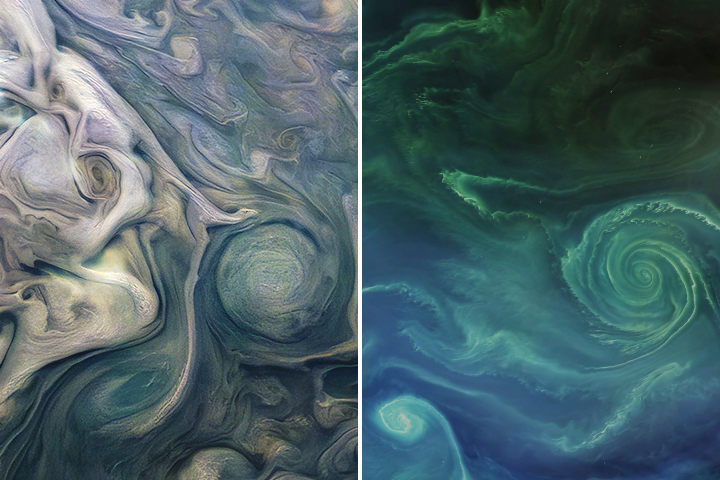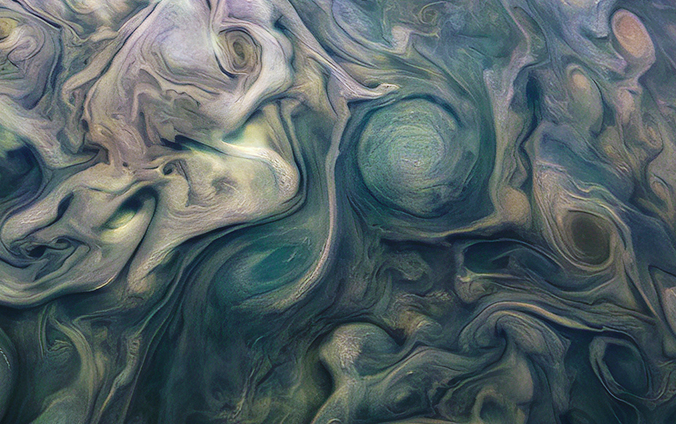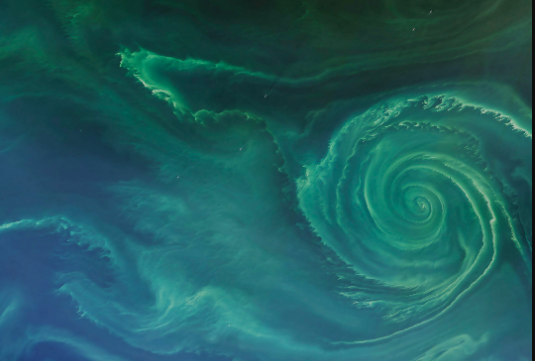

Swirls in Jupiter’s atmosphere (left) and swirls in Earth’s Baltic Sea (right). Image via Joshua Stevens/NASA Earth Observatory.
By Kathryn Hansen?NASA Earth Observatory.
It’s reasonable to think that Jupiter — a gaseous planet more than 11 times the diameter of Earth — would have little in common with our home. But it turns out that the motion of fluids on both planets is governed by the same laws of physics. An eddy on Earth looks a lot like an eddy on Jupiter.
The similarities are especially evident in these images showing swirls in Jupiter’s atmosphere and in Earth’s Baltic Sea. Norman Kuring, of NASA’s Goddard Space Flight Center. said:
This is all about fluids moving around on a rotating body.
Kuring described the patterns of flow as a combination of laminar (following a smooth path) and turbulent (uneven and chaotic). Flows can be characterized using numbers named for famous physicists, such as Reynolds, Rossby, and Rayleigh. But you don’t need a textbook knowledge of fluid dynamics to appreciate its consequences. Kuring said:
Out of all the complexity flows beauty, whether it be images of Earth, Jupiter, or your coffee cup when you pour in the cream.

Citizen scientists Gerald Eichstädt and Seán Doran created this image using data acquired by the JunoCam imager on NASA’s Juno spacecraft in December 2018. They applied a series of image processing steps to highlight details that would be difficult for the human eye to discern.Image via NASA Earth Observatory.
Scientists think Jupiter has three distinct cloud layers. The image above, taken by the Juno spacecraft, shows ammonia-rich clouds swirling in the planet’s outermost layer.
According to Alberto Adriani, a Juno mission co-investigator from the Institute for Space Astrophysics and Planetology, the eddies in Jupiter’s clouds reflect disturbances in the atmosphere caused by the planet’s fast rotation and by higher temperatures deeper in the atmosphere. He compares the phenomenon to rapidly rotating a fluid while boiling it.

The Operational Land Imager (OLI) on Landsat 8 acquired this image on July 18, 2018. Image via NASA Earth Observatory.
The patterns in Jupiter’s atmosphere appear similar to those in Earth’s oceans. The natural-color satellite image above shows a green phytoplankton bloom tracing the edges of a vortex in the Baltic Sea. In this medium—Earth’s ocean—turbulent processes are important for moving heat, carbon, and nutrients around the planet. Models that accurately represent these processes are critical for understanding weather in the air and sea.
While scientists continue exploring the complexities of Earth’s oceans, astronomers are learning more about Jupiter’s complex composition—important for understanding how our solar system and other solar systems formed. Kuring said:
In interpreting what we see elsewhere in the solar system and universe, we always compare with phenomena that we already know of on Earth. We work from the familiar toward the unknown.
Bottom line: Images compare swirling eddies on Jupiter and Earth.
from EarthSky https://ift.tt/2Fi5mm4


Swirls in Jupiter’s atmosphere (left) and swirls in Earth’s Baltic Sea (right). Image via Joshua Stevens/NASA Earth Observatory.
By Kathryn Hansen?NASA Earth Observatory.
It’s reasonable to think that Jupiter — a gaseous planet more than 11 times the diameter of Earth — would have little in common with our home. But it turns out that the motion of fluids on both planets is governed by the same laws of physics. An eddy on Earth looks a lot like an eddy on Jupiter.
The similarities are especially evident in these images showing swirls in Jupiter’s atmosphere and in Earth’s Baltic Sea. Norman Kuring, of NASA’s Goddard Space Flight Center. said:
This is all about fluids moving around on a rotating body.
Kuring described the patterns of flow as a combination of laminar (following a smooth path) and turbulent (uneven and chaotic). Flows can be characterized using numbers named for famous physicists, such as Reynolds, Rossby, and Rayleigh. But you don’t need a textbook knowledge of fluid dynamics to appreciate its consequences. Kuring said:
Out of all the complexity flows beauty, whether it be images of Earth, Jupiter, or your coffee cup when you pour in the cream.

Citizen scientists Gerald Eichstädt and Seán Doran created this image using data acquired by the JunoCam imager on NASA’s Juno spacecraft in December 2018. They applied a series of image processing steps to highlight details that would be difficult for the human eye to discern.Image via NASA Earth Observatory.
Scientists think Jupiter has three distinct cloud layers. The image above, taken by the Juno spacecraft, shows ammonia-rich clouds swirling in the planet’s outermost layer.
According to Alberto Adriani, a Juno mission co-investigator from the Institute for Space Astrophysics and Planetology, the eddies in Jupiter’s clouds reflect disturbances in the atmosphere caused by the planet’s fast rotation and by higher temperatures deeper in the atmosphere. He compares the phenomenon to rapidly rotating a fluid while boiling it.

The Operational Land Imager (OLI) on Landsat 8 acquired this image on July 18, 2018. Image via NASA Earth Observatory.
The patterns in Jupiter’s atmosphere appear similar to those in Earth’s oceans. The natural-color satellite image above shows a green phytoplankton bloom tracing the edges of a vortex in the Baltic Sea. In this medium—Earth’s ocean—turbulent processes are important for moving heat, carbon, and nutrients around the planet. Models that accurately represent these processes are critical for understanding weather in the air and sea.
While scientists continue exploring the complexities of Earth’s oceans, astronomers are learning more about Jupiter’s complex composition—important for understanding how our solar system and other solar systems formed. Kuring said:
In interpreting what we see elsewhere in the solar system and universe, we always compare with phenomena that we already know of on Earth. We work from the familiar toward the unknown.
Bottom line: Images compare swirling eddies on Jupiter and Earth.
from EarthSky https://ift.tt/2Fi5mm4

Aucun commentaire:
Enregistrer un commentaire